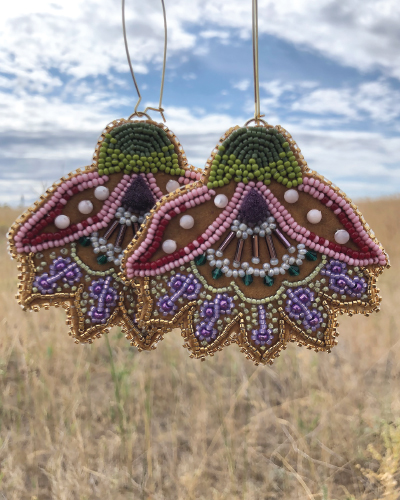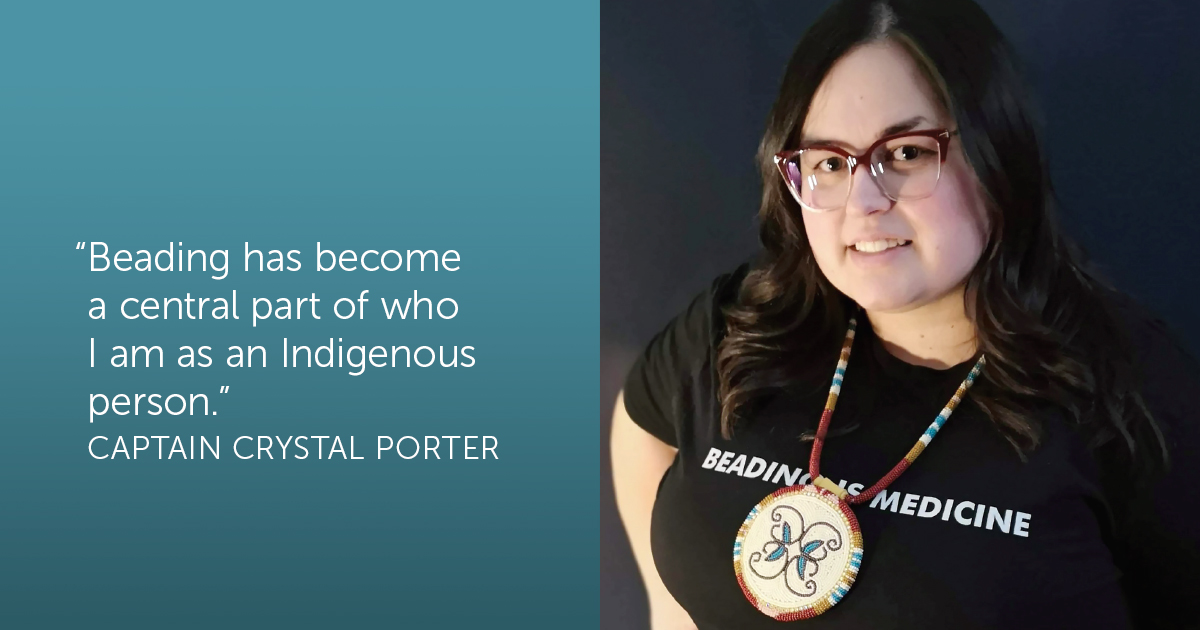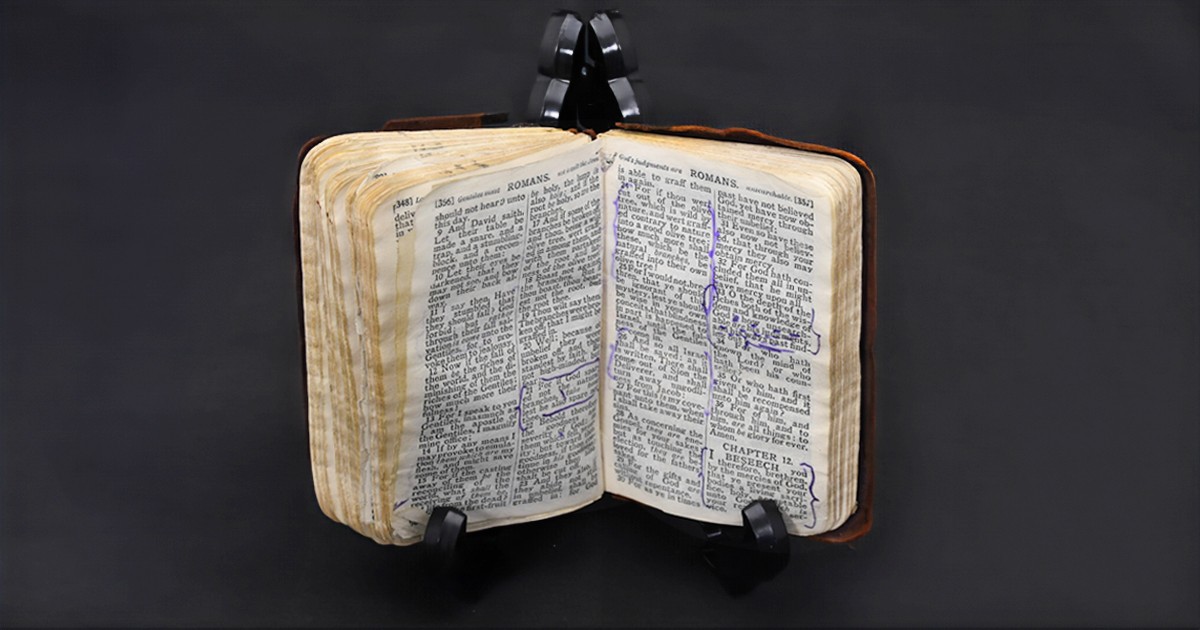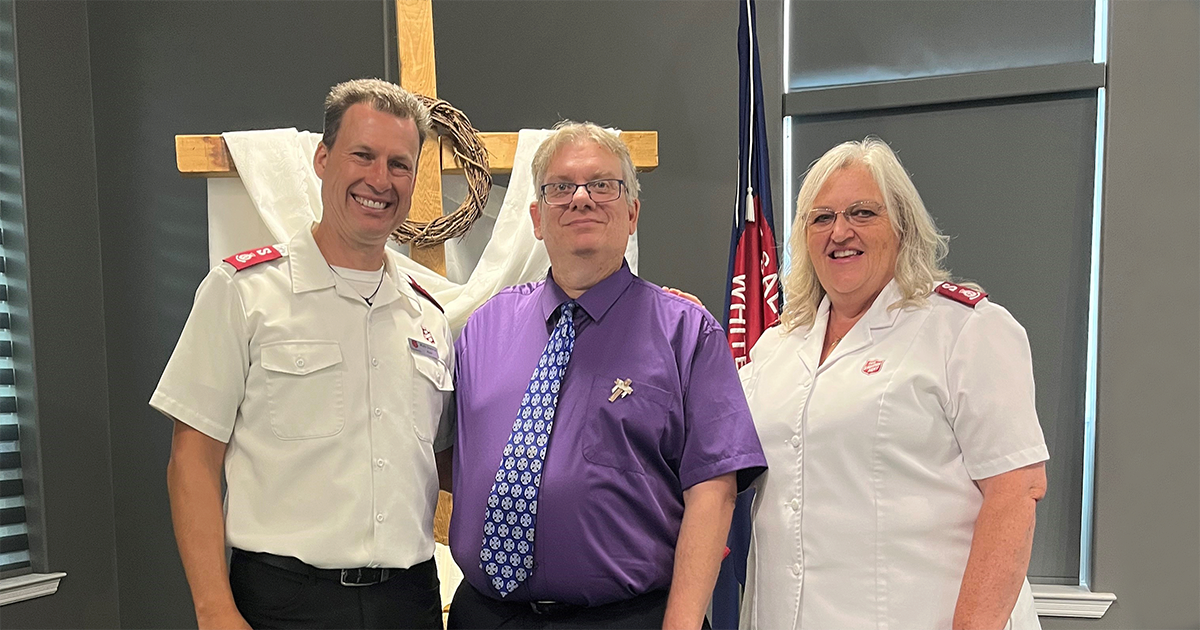(Above) Cpt Crystal Porter wears a medallion necklace she beaded using Mi’kmaq double curves, which represent balance within life
In season 3 of the Salvationist Podcast, host Brandon Laird spoke with Captain Crystal Porter, assistant territorial Indigenous ministries consultant and divisional youth secretary, Prairie Division, about her journey to reclaim her Indigenous identity, and how the craft of beading has connected her to the land and to her Indigenous community.
Tell us about the journey you’ve been on to reclaim your Indigenous heritage.
I remember it briefly coming up in conversation when I was growing up, but it wasn’t something our family focused on. And then I moved from Green’s Harbour, a small fishing village in Newfoundland and Labrador, to go to Booth University College in Winnipeg, and started attending Weetamah Corps. There were Indigenous people in the congregation, and I remember thinking, These people look like my grandma! Why do these people look like my grandma? I started asking questions within my family and discovered that my grandmother was Mi’kmaw.
 “I beaded these earrings on traditional braintanned caribou hide,” says Cpt Porter. “The colours were inspired by a ribbon skirt—a traditional piece of clothing in Indigenous nations—gifted to me from a friend”
“I beaded these earrings on traditional braintanned caribou hide,” says Cpt Porter. “The colours were inspired by a ribbon skirt—a traditional piece of clothing in Indigenous nations—gifted to me from a friend”
Beading has become a central part of who I am as an Indigenous person. When I first learned to bead, it was all about reconnecting to a part of myself that was lost. For a long time, struggling through my Indigenous identity, there wasn’t this connection point for me; I wasn’t part of a community. Learning to bead, and being able to do something that our ancestors couldn’t do, was huge for me. Learning the patterns and designs in beadwork just opened up this whole idea of connecting with ancestors who have gone before us, and realizing that there is this greater community, even beyond what we see, supporting and uplifting us.
In Scripture, we read about the clouds of witnesses, and how they continue to help us on our journey. Beadwork has been a huge part of that for me, because it connects me with the ones who have gone before us and have journeyed with us. Reclaiming my Indigenous heritage through beadwork reminds me of that community beyond what we see in the here and now.
How did you start beading?
Early in my journey to reclaim my culture, I attended a NAIITS (North American Institute for Indigenous Theological Studies) symposium in Chicago. It’s an academic community with all these brilliant Indigenous theologians, and I was so nervous. There was a lady in the back beading, and the whole weekend I was just mesmerized by the work she was doing. Eventually, I got the courage to go up to her, and she said, “Do you want to try?” and pulled up a chair. She showed me a few of the stitches, and then passed it over. I was so afraid I was going to mess it up! But she was so encouraging. At the end of the weekend, she gave me a bead kit, and told me to reach out if I had any questions. She didn’t know me, but she was so giving and gracious with her teaching.
How has beading given you a sense of community?
There’s a really cool network of beadwork artists on Instagram. We all follow each other. As we’re trying out new materials or working on different projects, people have been so willing to answer questions.
Right now, I’m working on a collar for my graduation ceremony from NAIITS, where I completed a master of theological studies in Indigenous studies. I‘ve been focusing on Mi’kmaq artwork. For different nations of Indigenous people, artwork looks different—if you’re a Métis beadwork artist, the flowers are going to be completely different than if you’re Mi’kmaq. I’m working on these double curves, and it’s cool to be able to connect with other Mi’kmaq beadwork artists, and ask, “Is this the right way to do this? Is this the right stitch to use when you’re working on moose hide?”
For so long, Indigenous ways of knowing and doing things weren’t appreciated. To be able to help and support each other just opens up this beautiful community of people wanting to learn about and reclaim their culture, and keep beadwork alive for the generations to come.
How is your craft connected to creation care?
I draw inspiration from creation— from flowers, even the colours of the sky. It keeps you mindful to care for creation and the materials that you use in beadwork. Recently, I’ve started to be more intentional about using traditional materials, such as smoked moose hides, and supporting Indigenous communities by buying materials from Indigenous artists.
Last summer, I had the most awesome experience—I received a porcupine from a camp staff member, who found it as roadkill on the way to the Army’s Beaver Creek Camp in Saskatchewan, and I’ve been incorporating the quills from the porcupine into my beadwork. Something I’ve learned is to give thanks, share and gift the things you have. When I was gifted this porcupine, I gave thanks, only took what I needed and then gave it back to creation. It makes you conscious of the materials that you’re using, but also how you live among creation.
When I draw inspiration from flowers or the sky, I want to ensure that others will also be able to draw the same inspiration in years to come. It’s about taking care of creation right now, so that in the future, there will still be a place from which to draw inspiration.
What kinds of things do you make?
I’ve done a few different projects. I love creating jewelry, medallions and earrings. It’s really cool to know that somebody else is walking around wearing your art. The biggest project I’ve done so far is a beaded medallion of a Mi’kmaq creation story—it was probably the size of an extra-large dinner plate.
One of the things I’ve learned is that you can’t bead when you’re frustrated or angry because it tightens the strings of your beadwork and it won’t lay flat properly. You are always supposed to bead with a good heart, a kind heart, because you’re beading for somebody else and they’re wearing your work.
Lately, I’ve been doing some birch bark and quill work. Some projects are art, some are gifts. I have my hand in all kinds of things.
What inspires your work? Are there colours, elements or themes that you return to?
When I’m out for a walk, I look at flowers or other colours, and I’ll see something that I wouldn’t necessarily have put together. That helps me experiment a little bit more with my colour choices. When I’m doing beadwork for other people, I usually ask what their favourite colour is. But I love it when they give me the freedom to experiment, to think about who the person is and what I identify with them. It helps me get to know the person more.
When I bead for somebody, it isn’t just a material that I’m processing and sending to them. It’s something that I’ve taken time to concentrate on, to learn more about them. I pray for them as I’m beading. That’s something else that an elder taught me—when you’re beading for someone, you’re praying for them. You’re praying for circumstances happening in their life now, but also things that might happen later in their life. So, when they wear your beadwork, they’re wearing good thoughts and prayers that have been prayed for them. Sometimes colours come through the inspiration of creation, sometimes colours come through prayers that I have for the people and good thoughts that I want them to have.
What story does your work tell?
I have a T-shirt that says, “Beading is medicine,” and that has been true for me—beading has been good medicine. It has been healing. When I think about me as a child, trying to find a place to belong, it felt like there was always part of me that was missing. When I started to bead, I was welcomed and embraced into this community of Indigenous beadwork artists, where if you have a question, you can just ask and people are so willing to help.
Every time I bead, I consciously realize the gift that the Creator has given me through my beadwork, that I’ve been able to reclaim my identity and find a place to belong, when I’ve always been searching for this place. Ultimately, that’s what I want. When somebody sees or wears my beadwork, I want them to realize the journey I was on to reclaim who I am.
With contributions by Giselle Randall.
This interview has been edited for space and clarity.
All episodes of the Salvationist podcast are available at Salvationist.ca/podcast.
This story is from:










Thank for sharing your story Captain Crystal. It is an honour to work alongside you. ~Lisa